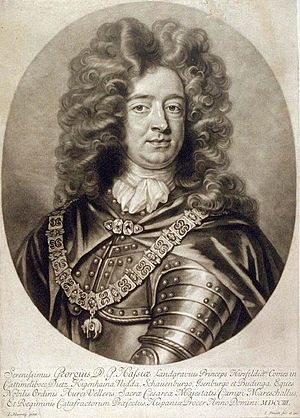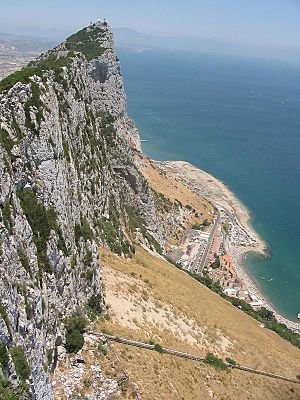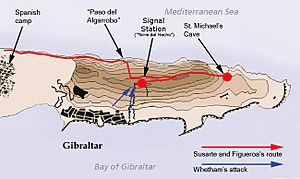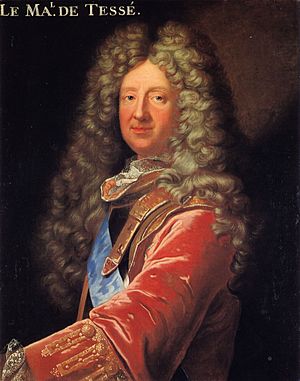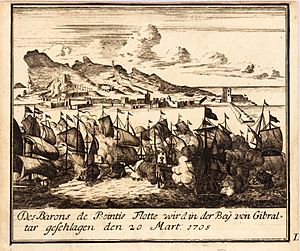Twelfth siege of Gibraltar facts for kids
Quick facts for kids Twelfth siege of Gibraltar |
|||||||
|---|---|---|---|---|---|---|---|
| Part of War of the Spanish Succession | |||||||
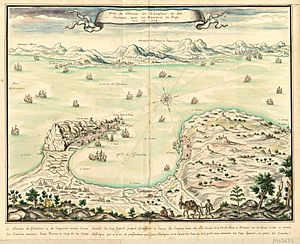 Veüe du d'Estroit de Gibraltar et des Environs, avec les tranchées du Siège mis en 1704, Louis Boudan |
|||||||
|
|||||||
| Belligerents | |||||||
| Commanders and leaders | |||||||
| Strength | |||||||
| 2,000 (start of the siege) | 8,000 (start of the siege) | ||||||
| Casualties and losses | |||||||
| 400 killed, missing, captured or died of disease | 10,000 killed, missing, captured or died of disease | ||||||
The Twelfth Siege of Gibraltar was a big battle that happened between September 1704 and May 1705. It was part of the War of the Spanish Succession. This war was about who would be the next king of Spain.
Just before the siege, in August 1704, a team of English and Dutch ships, led by Sir George Rooke, had captured the town of Gibraltar. Gibraltar is a strong, fortified town at the very tip of Spain.
The battle was between two main groups:
- The Grand Alliance: This group included England, the Netherlands, Austria, Portugal, and some Spanish people who supported the Habsburg family. They wanted Archduke Charles to be King of Spain.
- The Bourbon Forces: This group included France and most of Spain, who supported Philip, Duke of Anjou. He was already ruling as Philip V of Spain.
At the start of the siege, about 2,000 soldiers from the Grand Alliance were defending Gibraltar. They faced a much larger force of up to 8,000 French and Spanish soldiers. Even though they were outnumbered, the defenders used Gibraltar's natural defenses and strong walls to hold off the attackers. Control of the sea was very important, as ships brought fresh troops and supplies to the defenders. After nine months of fighting, the Bourbon forces gave up. This was a big win for the Grand Alliance.
Contents
Why Gibraltar Was So Important
Losing Gibraltar was a big problem for Philip V, the Bourbon king of Spain. It was the first Spanish town to be taken from him. Also, it was a great entry point for the Grand Alliance armies.
Prince George of Hesse-Darmstadt, who led the Alliance forces, knew this. He said Gibraltar was "a door through which to enter Spain." An army landing there could quickly move along the coast. They could capture the important port of Cadiz. From Cadiz, it was a short trip to Seville. There, Archduke Charles could be declared king. Then, the Alliance could march to Madrid and end the war.
Most people had left Gibraltar after it was captured. Only a few Spanish and Genoese people stayed. The town was defended by about 2,000 British and Dutch marines, gunners, and Spanish soldiers who supported Charles. Sir George Rooke's fleet of 51 ships also helped.
The Alliance had two problems. They had limited supplies. Also, their ships had been at sea for six months and needed repairs.
Preparing for the Siege
After capturing Gibraltar, the Alliance got ready for a counter-attack. Rooke's fleet went to Tetuan in Morocco for fresh water. On August 22, a French fleet was seen but started to leave. Rooke chased them near Málaga and attacked on August 24. He wanted to stop them from attacking Gibraltar.
The two fleets were about equal in strength. But the French ships were faster and had more ammunition. The battle, called the Battle of Vélez-Málaga, was a draw. No ships were sunk, but many men were hurt or killed on both sides. The Anglo-Dutch fleet ran low on ammunition. Luckily, the French left the next day. This allowed the Anglo-Dutch fleet to return to Gibraltar.
Rooke left as many men, guns, and supplies as he could at Gibraltar. Then he sailed home. He left Admiral Sir John Leake with 18 ships to patrol the area. The Spanish had already gathered their forces. In early September, the Marquis of Villadarias arrived near Gibraltar. He had an army of 4,000 men. Villadarias planned to increase his force to 12,000 soldiers. Many civilians who had left Gibraltar also joined the Bourbon forces.
The Siege Begins
Hesse worked to make Gibraltar's defenses stronger. He wanted to make a direct attack very hard. Gibraltar is on the west side of a rocky peninsula. It is connected to Spain by a narrow sandy strip of land. The north side of the Rock of Gibraltar is a steep cliff. The only way into town was through a narrow path. This path was blocked by a strong wall called the Muralla de San Bernardo.
Hesse tried to make this path even narrower by flooding it. This forced attackers to use a very small path. He placed cannons in five batteries along the north side of Gibraltar. These cannons could fire from different angles. A "bomb ship" with a heavy mortar was also placed off the Old Mole.
Hesse was sure he could hold Gibraltar. But there were arguments between the Habsburg and English commanders. Many English marines were upset they couldn't go home with Rooke's fleet. There was a bad relationship between Colonel Edward Fox (English) and Colonel Henry Nugent (Irish). Hesse had made Nugent the Governor of Gibraltar. These two men had fought on opposite sides in a past war. Hesse wrote that Fox was "furious at being under my orders."
The French and Spanish forces got stronger on October 4. Nineteen French warships brought 3,000 men, heavy guns, and supplies. This brought Villadarias's army to about 7,000 soldiers. Most French ships left on October 24, but six stayed to block Gibraltar.
The Spanish began digging trenches towards the defenders. The first attack was on October 26. Spanish guns fired on the Round Tower, causing damage. A French force also attacked Gibraltar's harbor, burning the bomb ship. Villadarias then heavily bombed the San Pablo bastion. This caused a breach in the wall. Both Colonel Fox and Colonel Nugent were killed. At the same time, a disease spread among the Gibraltar soldiers. This reduced their numbers to about 1,300 men.
The situation for the defenders looked very bad. Hesse sent a message to Admiral Leake in Lisbon, asking for help. Leake sailed at once with more supplies. Meanwhile, Hesse had to deal with a plot inside the garrison. Some Spanish officers, helped by others, planned to betray the defenders. The plotters were caught. One of them, Gonzalez, was found guilty and shot on February 23, 1705.
Surprise Attack on the East Side
The Bourbon Spanish planned a surprise attack. Simón Susarte, a Spanish goatherd, knew a secret path up the east side of the Rock. This path was very steep, about 400 meters high. The top part was almost straight up. But it could be climbed using ropes and ladders. The east side was thought to be impossible to climb. So, only the west side was fortified. If attackers could climb the east side, they could get into the town without facing the main defenses.
Villadarias decided to send 2,000 men. The first 500 would climb at night to take the high ground. The other 1,500 would follow at daybreak. The first 500 men set off on November 11. They were led by Colonel Figueroa and guided by Simón Susarte. They reached the top of the Rock and hid overnight in St. Michael's Cave. At daybreak, they climbed the Moorish Wall and killed the English guards at Middle Hill. A drummer boy saw them and raised the alarm.
Hesse had expected an attack from the rear. He had a mobile force ready to defend against it. This force included English and Spanish soldiers, about 300 men in total. They were led by Hesse's brother, Heinrich. This group quickly attacked the Spanish Bourbons at Middle Hill. The Bourbons were trapped against the cliff. They had very little ammunition.
The Spanish Habsburg force attacked first. They pushed the Bourbon soldiers from the top of the hill. Other groups attacked from the sides. About 100 Bourbon soldiers, including their colonel, were captured. Hundreds more were killed, either by gunfire or by falling off the Rock while trying to escape. Only a few, including Simón Susarte, made it back to their lines. The English later destroyed the path the Spanish had used.
The other 1,500 Spanish soldiers did not even start their climb. This was because Admiral Leake's squadron of 20 ships was seen entering the bay. In a naval battle, six French ships were destroyed, and one was captured. Leake's arrival meant Villadarias's multi-part attack failed. The French naval support disappeared. A direct attack on the main defenses also failed. Hesse was very relieved. He thanked Leake for arriving just as "the enemy were attacking us that very night."
Leake didn't bring many supplies. But he gave what he could. He also loaned Hesse skilled sailors, which the defenders badly needed. About 500 men from the ships helped repair the walls. They also moved cannons up the Rock to fire on the Spanish. Captain Willis was one of these men. The path he used is still called Willis' Road.
The siege became a routine of bombing and counter-bombing. This was hard for the defenders. They were running out of men, ammunition, and supplies. Captain Joseph Bennett, an engineer, helped strengthen the walls. But some soldiers wanted to give up. Bennett wrote that "many officers had a design to quit the place."
Many soldiers tried to sneak onto Leake's ships to escape. The situation got worse when a storm damaged Leake's ships in December. The garrison was very short on medicine and supplies. Many were sick or hurt. Only 1,300 men were healthy enough to fight. Their living conditions were terrible. Many had no shoes and wore sandals made from hay.
More Troops Arrive
A few days later, Leake heard that 20 supply ships were coming from Lisbon. They were protected by four warships. Bad winds stopped Leake from helping them. On December 18, nine of the supply ships reached the bay. Seven more arrived on December 20. Four were missing, captured by the French. These ships brought 2,200 new soldiers, plus guns, powder, tools, and food. More troops arrived in January. With Gibraltar safer, Leake left for Lisbon on January 3. He took the sick and wounded soldiers with him.
The Bourbon Spanish and French forces kept bombing Gibraltar. They damaged the walls but couldn't break through the stronger defenses. The defenders fired back, killing many attackers. They also made two successful attacks on December 23 and 31.
Relations between the Spanish and French forces got worse. They were not making progress. Conditions were terrible, and many soldiers were getting sick or hurt. The weather was also bad, with storms and heavy rain. By early 1705, the attacking army was falling apart. Their numbers dropped from 7,000 to only 4,000. Many had been hurt or had left.
King Louis XIV of France sent Marshal René de Froulay de Tessé with 4,500 French and Irish soldiers. He wanted to fix the situation. But Villadarias wanted to try one more attack before Tessé arrived. On February 7, he sent 1,500 troops to take the Round Tower. They captured it, but a counter-attack drove them out. Two hundred attackers were killed. The Spanish accused the French of running away.
Tessé arrived in mid-February. He was shocked by how badly the siege was going. His criticism made some Spanish officers leave. Their spirits improved when Admiral Bernard Desjean, Baron de Pointis arrived on February 26 with 18 warships. Gibraltar's defenders expected a landing, but it didn't happen. The reason became clear: Leake had returned with 35 ships from England, the Netherlands, and Portugal. In the battle that followed, the French lost five ships. Pointis himself was badly wounded. Leake's fleet sailed into the bay on March 31, bringing more troops.
The Siege Ends
Leake's arrival was "the final stroke." The French gave up the siege. King Louis XIV ordered them to stop on April 12.
Tessé blamed the Spanish for the failure. He wrote to the king that they failed "for want of method and planning." With the French gone, Villadarias took command again. He turned the siege into a blockade. He pulled back his troops and removed his cannons. On May 2, Alliance scouts found that the Spanish trenches were empty. Later that day, Hesse's men destroyed the Bourbon Spanish works. The next day, a larger group finished destroying the Spanish batteries. This marked the end of the siege.
What Happened Next
Gibraltar stayed in Grand Alliance hands for the rest of the war. After the siege, George of Hesse left Gibraltar. He went to lead the capture of Barcelona. He was later killed on September 13, 1705, while attacking the citadel of Montjuich.
After Hesse left, Major General John Shrimpton became the British commander of Gibraltar. He governed it for Archduke Charles. Queen Anne later declared Gibraltar a free port. This meant ships could trade there easily. Shrimpton was replaced by Colonel Roger Elliott in 1707. Then Brigadier Thomas Stanwix took over in 1711. These leaders were chosen directly by London. Stanwix was told to remove all foreign troops from Gibraltar. This was to make it a British possession. But he didn't remove the Dutch troops, as he didn't see them as "foreign."
The War of the Spanish Succession ended in 1713 with the Treaty of Utrecht. Philip V was accepted as King of Spain. But he promised that the crowns of France and Spain would never be joined. Many lands were exchanged. Gibraltar and Menorca were given to Great Britain "for ever." The treaty also said that if Britain ever wanted to get rid of Gibraltar, it had to offer it to Spain first.
Gibraltar, as a British possession, faced two more sieges. Both ended in British victories. The first was in 1727. The second was from 1779 to 1783. This was the largest and longest siege.
See also
 In Spanish: Sitio de Gibraltar (1704-1705) para niños
In Spanish: Sitio de Gibraltar (1704-1705) para niños



